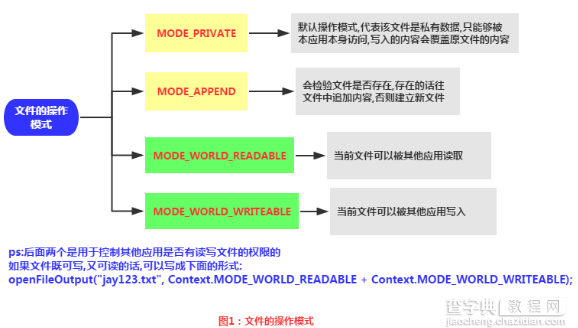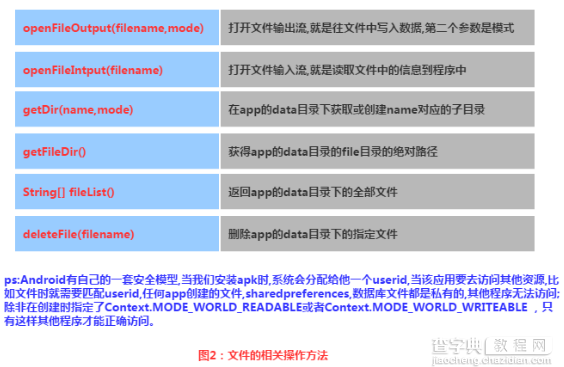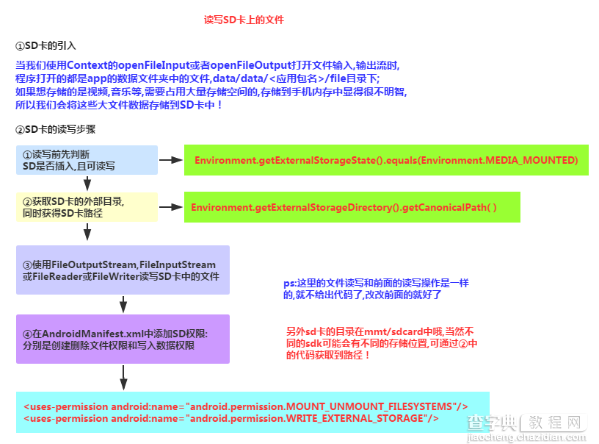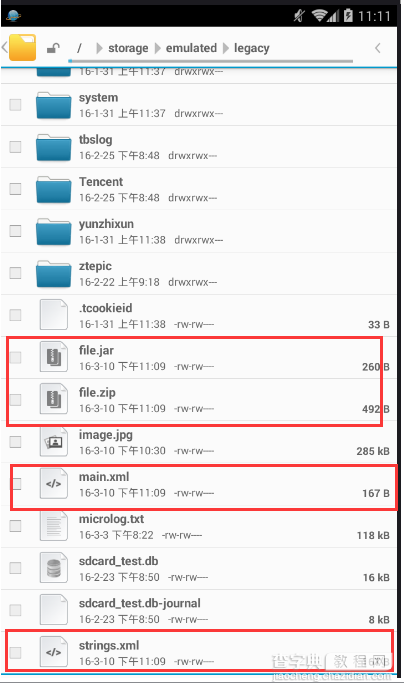文件存储是 Android 中最基本的一种数据存储方式,它不对存储的内容进行任何的格式化处理,所有数据都是原封不动的保存到文件当中的。
概述
文件存取的核心就是输入流和输出流。
Android文件的操作模式

文件的相关操作方法

文件读写的实现
openFileOutput和openFileInput方法
/** * openFIleOutput ,openFileInput * 这两种方法同sp一样只能讲文件保存到手机内存固定的路径中, * 默认为 /data/data/<packageName>/files */ private void save2File() { try { //向文件写入内容 FileOutputStream os = openFileOutput("file.txt", Context.MODE_PRIVATE); String text = "写数据到文件"; os.write(text.getBytes("utf-8")); //关闭流 os.close(); } catch (FileNotFoundException e) { e.printStackTrace(); } catch (UnsupportedEncodingException e) { e.printStackTrace(); } catch (IOException e) { e.printStackTrace(); } } /** * */ private void readFile() { try { FileInputStream ins = openFileInput("file.txt"); byte[] buffer = new byte[100]; int byteCount = ins.read(buffer); String text = new String(buffer,0,byteCount,"utf-8"); Toast.makeText(this,text,Toast.LENGTH_SHORT).show(); ins.close(); } catch (FileNotFoundException e) { e.printStackTrace(); } catch (IOException e) { e.printStackTrace(); } }
文件存储位置
/data/data/<package-name>/files目录下
openFileOutput和openFileInput方法可以获得操作文件的OutputStream以及InputStream对象,而且可以通过流对象处理任何文件的数据,但是这两个方法同SharedPreferences一样,只能在手机内存卡的指定目录建立文件,因此在使用上仍然有一定的局限性。
读取SD卡上的文件

main_activity.xml:
<LinearLayout xmlns:android="http://schemas.android.com/apk/res/android" xmlns:tools="http://schemas.android.com/tools" android:id="@+id/LinearLayout1" android:layout_width="match_parent" android:layout_height="match_parent" android:orientation="vertical" tools:context="com.jay.example.filedemo2.MainActivity"> <TextView android:layout_width="wrap_content" android:layout_height="wrap_content" android:text="清输入文件名" /> <EditText android:id="@+id/edittitle" android:layout_width="match_parent" android:layout_height="wrap_content" android:hint="文件名" /> <TextView android:layout_width="wrap_content" android:layout_height="wrap_content" android:text="清输入文件内容" /> <EditText android:id="@+id/editdetail" android:layout_width="match_parent" android:layout_height="wrap_content" android:hint="文件内容" /> <Button android:id="@+id/btnsave" android:layout_width="wrap_content" android:layout_height="wrap_content" android:text="保存到SD卡" /> <Button android:id="@+id/btnclean" android:layout_width="wrap_content" android:layout_height="wrap_content" android:text="清空" /> <Button android:id="@+id/btnread" android:layout_width="wrap_content" android:layout_height="wrap_content" android:text="读取sd卡中的文件" /> </LinearLayout>
接着我们来写一个SD操作类: SDFileHelper.Java
public class SDFileHelper { private Context context; public SDFileHelper() { } public SDFileHelper(Context context) { super(); this.context = context; } //往SD卡写入文件的方法 public void savaFileToSD(String filename, String filecontent) throws Exception { //如果手机已插入sd卡,且app具有读写sd卡的权限 if (Environment.getExternalStorageState().equals(Environment.MEDIA_MOUNTED)) { filename = Environment.getExternalStorageDirectory().getCanonicalPath() + "/" + filename; //这里就不要用openFileOutput了,那个是往手机内存中写数据的 FileOutputStream output = new FileOutputStream(filename); output.write(filecontent.getBytes()); //将String字符串以字节流的形式写入到输出流中 output.close(); //关闭输出流 } else Toast.makeText(context, "SD卡不存在或者不可读写", Toast.LENGTH_SHORT).show(); } //读取SD卡中文件的方法 //定义读取文件的方法: public String readFromSD(String filename) throws IOException { StringBuilder sb = new StringBuilder(""); if (Environment.getExternalStorageState().equals(Environment.MEDIA_MOUNTED)) { filename = Environment.getExternalStorageDirectory().getCanonicalPath() + "/" + filename; //打开文件输入流 FileInputStream input = new FileInputStream(filename); byte[] temp = new byte[1024]; int len = 0; //读取文件内容: while ((len = input.read(temp)) > 0) { sb.append(new String(temp, 0, len)); } //关闭输入流 input.close(); } return sb.toString(); } }
接着MainActivity.java实现相关逻辑:
public class MainActivity extends AppCompatActivity implements View.OnClickListener{ private EditText editname; private EditText editdetail; private Button btnsave; private Button btnclean; private Button btnread; private Context mContext; @Override protected void onCreate(Bundle savedInstanceState) { super.onCreate(savedInstanceState); setContentView(R.layout.activity_main); mContext = getApplicationContext(); bindViews(); } private void bindViews() { editname = (EditText) findViewById(R.id.edittitle); editdetail = (EditText) findViewById(R.id.editdetail); btnsave = (Button) findViewById(R.id.btnsave); btnclean = (Button) findViewById(R.id.btnclean); btnread = (Button) findViewById(R.id.btnread); btnsave.setOnClickListener(this); btnclean.setOnClickListener(this); btnread.setOnClickListener(this); } @Override public void onClick(View v) { switch (v.getId()){ case R.id.btnclean: editdetail.setText(""); editname.setText(""); break; case R.id.btnsave: String filename = editname.getText().toString(); String filedetail = editdetail.getText().toString(); SDFileHelper sdHelper = new SDFileHelper(mContext); try { sdHelper.savaFileToSD(filename, filedetail); Toast.makeText(getApplicationContext(), "数据写入成功", Toast.LENGTH_SHORT).show(); } catch(Exception e){ e.printStackTrace(); Toast.makeText(getApplicationContext(), "数据写入失败", Toast.LENGTH_SHORT).show(); } break; case R.id.btnread: String detail = ""; SDFileHelper sdHelper2 = new SDFileHelper(mContext); try { String filename2 = editname.getText().toString(); detail = sdHelper2.readFromSD(filename2); } catch(IOException e){e.printStackTrace();} Toast.makeText(getApplicationContext(), detail, Toast.LENGTH_SHORT).show(); break; } } }
最后别忘记在AndroidManifest.xml写上读写SD卡的权限哦!
<> <uses-permission android:name="android.permission.MOUNT_UNMOUNT_FILESYSTEMS"/> <> <uses-permission android:name="android.permission.WRITE_EXTERNAL_STORAGE"/>
如何判断虚拟和物理两种SDK
在默认情况下,会将一部分存储空间分给虚拟的SD卡使用(一部分用于安装Android操作系统)
android.os.Enviroment.isExternalStorageRemovalbe()
返回true:SD卡是物理的,反之SD卡是虚拟的。
用于适配不同型号手机,反射获取SD卡路径和状态
package com.turing.base.activity.dataStore.fileStore; import android.content.Context; import android.os.Environment; import android.os.StatFs; import android.os.storage.StorageManager; import android.text.TextUtils; import android.util.Log; import java.io.File; import java.lang.reflect.InvocationTargetException; import java.lang.reflect.Method; import java.util.concurrent.ConcurrentLinkedQueue; import java.util.concurrent.ExecutorService; import java.util.concurrent.Executors; /** * 用于适配不同型号手机,反射获取SD卡路径和状态 * */ public class DevMountInfo { private final String TAG = DevMountInfo.class.getSimpleName(); private static final int ERROR = -1; // class name private final static String CLASS_NAME = "android.os.storage.StorageVolume"; //remained spare memory size private static final int REMAINED_SPARE_IN_MB = 100; // method name private final static String METHOD_GET_VOLUME_LIST = "getVolumeList"; private final static String METHOD_GET_VOLUME_STATE = "getVolumeState"; private final static String METHOD_IS_REMOVABLE = "isRemovable"; private final static String METHOD_GET_PATH = "getPath"; private final static String MOUNTED = "mounted"; private static DevMountInfo INSTANCE; private String mSDCardPath = null; // internal file path private ConcurrentLinkedQueue<String> mInternalPathList = new ConcurrentLinkedQueue<String>(); // external file path private ConcurrentLinkedQueue<String> mExternalPathList = new ConcurrentLinkedQueue<String>(); private ExecutorService mExecutor = null; private DevMountInfo() { mExecutor = Executors.newSingleThreadExecutor(); } public static DevMountInfo getInstance() { synchronized (DevMountInfo.class) { if (null == INSTANCE) { INSTANCE = new DevMountInfo(); } return INSTANCE; } } @Override protected void finalize() throws Throwable { super.finalize(); synchronized (DevMountInfo.class) { mInternalPathList.clear(); mExternalPathList.clear(); mExecutor.shutdown(); INSTANCE = null; } } public void init(final Context context) { mExecutor.execute(new Runnable() { @Override public void run() { executeInit(context); } }); } public boolean isSDCardFull() { return REMAINED_SPARE_IN_MB > (getSDCardAvailSpace() * 1024); } public boolean isSDCardAvaiable() { return !mExternalPathList.isEmpty() || !mInternalPathList.isEmpty(); } public String getSDCardPath() { return mSDCardPath; } public long getSDCardTotalSpace() { long totalSpace = 0; if (!TextUtils.isEmpty(mSDCardPath)) { StatFs sf = new StatFs(mSDCardPath); long blockSize = sf.getBlockSize(); long total = sf.getBlockCount(); totalSpace = total * blockSize / 1024; } return totalSpace; } public long getSDCardAvailSpace() { long availSpace = 0; if (!TextUtils.isEmpty(mSDCardPath)) { StatFs sf = new StatFs(mSDCardPath); long blockSize = sf.getBlockSize(); long availCount = sf.getAvailableBlocks(); availSpace = availCount * blockSize / 1024; } return availSpace; } public String getInternalSDCardPath() { return mInternalPathList.peek(); } public String getExternalSDCardPath() { return mExternalPathList.peek(); } private void executeInit(Context context) { StorageManager mStorageManager = (StorageManager) context.getSystemService(Context.STORAGE_SERVICE); if (mStorageManager != null) { Class<?> mStorageVolume = null; Method mGetVolumeListMethod = null; Method mGetVolumeStateMethod = null; Method mGetPathMethod = null; Method mIsRemovableMethod = null; Object[] mStorageVolumeList = null; try { mStorageVolume = Class.forName(CLASS_NAME); mGetVolumeListMethod = mStorageManager.getClass().getMethod(METHOD_GET_VOLUME_LIST, new Class[0]); mGetVolumeStateMethod = mStorageManager.getClass().getMethod(METHOD_GET_VOLUME_STATE, new Class[]{String.class}); mIsRemovableMethod = mStorageVolume.getMethod(METHOD_IS_REMOVABLE, new Class[0]); mGetPathMethod = mStorageVolume.getMethod(METHOD_GET_PATH, new Class[0]); mStorageVolumeList = (Object[]) mGetVolumeListMethod.invoke(mStorageManager, new Object[0]); boolean mIsRemovable = false; if (mStorageVolumeList != null && mStorageVolumeList.length > 0) { int mStorageVolumeCount = mStorageVolumeList.length; Log.i(TAG, "init() === > StorageVolume Count = " + mStorageVolumeCount); mInternalPathList.clear(); mExternalPathList.clear(); for (int i = 0; i < mStorageVolumeCount; ++i) { String mStoragePath = (String) mGetPathMethod.invoke(mStorageVolumeList[i], new Object[0]); mIsRemovable = ((Boolean) mIsRemovableMethod.invoke(mStorageVolumeList[i], new Object[0])).booleanValue(); if (!TextUtils.isEmpty(mStoragePath)) { String state = (String) mGetVolumeStateMethod.invoke(mStorageManager, new Object[]{mStoragePath}); if ((state != null) && (state.equals(MOUNTED))) { if (mIsRemovable) { Log.i(TAG, "init() === > external storage path = (" + mStoragePath + ")"); mExternalPathList.add(mStoragePath); } else { Log.i(TAG, "init() === > internal storage path = (" + mStoragePath + ")"); mInternalPathList.add(mStoragePath); } } } } } } catch (ClassNotFoundException e) { handleInvalid(); Log.e(TAG, "init() === > Exception:ClassNotFoundException"); } catch (NoSuchMethodException e) { handleInvalid(); Log.e(TAG, "init() === > Exception:NoSuchMethodException"); } catch (IllegalArgumentException e) { handleInvalid(); Log.e(TAG, "init() === > Exception:IllegalArgumentException"); } catch (IllegalAccessException e) { handleInvalid(); Log.e(TAG, "init() === > Exception:IllegalAccessException"); } catch (InvocationTargetException e) { handleInvalid(); Log.e(TAG, "init() === > Exception:InvocationTargetException"); } } else { handleInvalid(); Log.e(TAG, "init() === > can't get storage manager"); } initSDCardPath(); } private void handleInvalid() { mInternalPathList.add(Environment.getExternalStorageDirectory().getPath()); } private void initSDCardPath() { if (!mExternalPathList.isEmpty()) { mSDCardPath = mExternalPathList.peek(); } else if (!mInternalPathList.isEmpty()) { mSDCardPath = mInternalPathList.peek(); } else { mSDCardPath = Environment.getExternalStorageDirectory().getPath(); } Log.i(TAG, "initSDCardPath() === > SDCARD PATH = (" + mSDCardPath + ")"); } /** * SDCARD是否存 */ public static boolean externalMemoryAvailable() { return android.os.Environment.getExternalStorageState().equals( android.os.Environment.MEDIA_MOUNTED); } /** * 获取手机内部剩余存储空间 * * @return */ public static long getAvailableInternalMemorySize() { File path = Environment.getDataDirectory(); StatFs stat = new StatFs(path.getPath()); long blockSize = stat.getBlockSize(); long availableBlocks = stat.getAvailableBlocks(); return availableBlocks * blockSize; } /** * 获取手机内部总的存储空间 * * @return */ public static long getTotalInternalMemorySize() { File path = Environment.getDataDirectory(); StatFs stat = new StatFs(path.getPath()); long blockSize = stat.getBlockSize(); long totalBlocks = stat.getBlockCount(); return totalBlocks * blockSize; } /** * 获取手机内置存储剩余存储空间 * * @return */ public static long getAvailableInternalSystemMemorySize() { File path = Environment.getRootDirectory(); StatFs stat = new StatFs(path.getPath()); long blockSize = stat.getBlockSize(); long availableBlocks = stat.getAvailableBlocks(); return availableBlocks * blockSize; } /** * 获取手机内置存储总的存储空间 * * @return */ public static long getTotalInternalSystemMemorySize() { File path = Environment.getRootDirectory(); StatFs stat = new StatFs(path.getPath()); long blockSize = stat.getBlockSize(); long totalBlocks = stat.getBlockCount(); return totalBlocks * blockSize; } /** * 获取SDCARD剩余存储空间 * * @return */ public static long getAvailableExternalMemorySize() { if (externalMemoryAvailable()) { File path = Environment.getExternalStorageDirectory(); StatFs stat = new StatFs(path.getPath()); long blockSize = stat.getBlockSize(); long availableBlocks = stat.getAvailableBlocks(); return availableBlocks * blockSize; } else { return ERROR; } } /** * 获取SDCARD总的存储空间 * * @return */ public static long getTotalExternalMemorySize() { if (externalMemoryAvailable()) { File path = Environment.getExternalStorageDirectory(); StatFs stat = new StatFs(path.getPath()); long blockSize = stat.getBlockSize(); long totalBlocks = stat.getBlockCount(); return totalBlocks * blockSize; } else { return ERROR; } } public static long getAvailableMemorySize(String path) { if (null == path) return 0; StatFs stat = new StatFs(path); long blockSize = stat.getBlockSize(); long availableBlocks = stat.getAvailableBlocks(); return availableBlocks * blockSize; } }
读取raw和assets文件夹下的文件
相信大家对两个文件夹并不陌生,如果我们不想自己的文件被编译成二进制文件的话, 我们可以把文件放到这两个目录下,而两者的区别如下:
res/raw:文件会被映射到R.java文件中,访问的时候直接通过资源ID即可访问,而且 他不能有目录结构,就是不能再创建文件夹 assets:不会映射到R.java文件中,通过AssetManager来访问,能有目录结构,即, 可以自行创建文件夹。
读取文件资源:
res/raw:
InputStream is =getResources().openRawResource(R.raw.filename);
assets:
AssetManager am = getAssets(); InputStream is = am.open("filename");
SAX引擎读取XML文件
sax引擎读取xml文件的原理:
sax技术在处理xml文件时并不一次性把xml文件装入内存,而是一边读一般解析。
使用sax处理xml需要一个Handler对象,一般会使用org.xml.sax.helpers.DefaultHandler的子类作为Handler对象
因此,这就需要处理如下5个分析点,也可称为分析事件:
开始分析xml文件。该分析点表示sax引擎刚开始处理xml文件,还没有读取xml文件中的内容。该分析点对应于DefaultHandler类中的startDocument()事件方法,可以在该方法中做一下初始化的工作! 开始处理每一个xml元素,也就是遇到<product>,<item>这样的起始标记,sax引擎每次扫描到新的xml元素的起始标记会触发这个分析事件,对应的事件分析方法是startElement,在该方法中可以获取当前元素的名称和元素属性的相关信息 处理完一个xml元素,也就是遇到</product>,</item>这样的结束标记,该分析点对应的事件方法是endElement,在该事件中可以获得当前处理完的元素的全部信息。 处理完xml文件。如果sax引擎将整个xml文件的内容都扫描完了,就到了这个分析点,该分析点对应的事件方法endDocument(),该事件方法可能不是必需的,如果最后有以下收尾工作,如释放一下资源,可以在该方法中完成! 读取字符分析点。这是最重要的分析点。如果没有这个分析点,前4步的处理相当于白跑一遍,虽然读取了xml文件中的所有内容,但并未保存这些内容,而这个分析点所对应的characters事件方法的主要作用就是保存sax引擎读取的xml文件中的内容。更准确地说是保存xml元素的文本,也就是<product>abc</product>中的abc。
Code
resrawproduct.xml
<"1.0" encoding="utf-8"?> <products> <product> <id>10</id> <name>电脑</name> <price>2067.25</price> </product> <product> <id>20</id> <name>微波炉</name> <price>520</price> </product> <product> <id>30</id> <name>洗衣机</name> <price>2400</price> </product> </products>
Product.java
public class Product { private int id; private String name; private float price; public int getId() { return id; } public void setId(int id) { this.id = id; } public String getName() { return name; } public void setName(String name) { this.name = name; } public float getPrice() { return price; } public void setPrice(float price) { this.price = price; } }
XML2Product.java(DefaultHandler子类)
DefaultHandler子类 ,核心类,负责处理分析点事件。
import org.xml.sax.Attributes; import org.xml.sax.SAXException; import org.xml.sax.helpers.DefaultHandler; import java.util.ArrayList; import java.util.List; public class XML2Product extends DefaultHandler { private List<Product> products; private Product product; private StringBuffer buffer = new StringBuffer(); public List<Product> getProducts() { return products; } @Override public void characters(char[] ch, int start, int length) throws SAXException { buffer.append(ch, start, length); super.characters(ch, start, length); } @Override public void startDocument() throws SAXException { // 开始分析xml文件,创建List对象用于保存分析完的Product对象 products = new ArrayList<Product>(); } @Override public void startElement(String uri, String localName, String qName, Attributes attributes) throws SAXException { if (localName.equals("product")) { // 如果分析的是<product>标签,则创建一个Product对象 product = new Product(); } super.startElement(uri, localName, qName, attributes); } @Override public void endElement(String uri, String localName, String qName) throws SAXException { if (localName.equals("product")) { // 处理完 <product>标签后 将product对象添加到products中 products.add(product); } else if (localName.equals("id")) { // 设置id属性的值 product.setId(Integer.parseInt(buffer.toString().trim())); // 将标签内容的缓存区清空 buffer.setLength(0); } else if (localName.equals("name")) { product.setName(buffer.toString().trim()); buffer.setLength(0); } else if (localName.equals("price")) { product.setPrice(Float.parseFloat(buffer.toString().trim())); buffer.setLength(0); } super.endElement(uri, localName, qName); } }
Xml2JavaObjectAct
import android.app.AlertDialog; import android.os.Bundle; import android.support.v7.app.AppCompatActivity; import android.util.Xml; import android.view.View; import com.turing.base.R; import java.io.InputStream; import java.util.List; public class Xml2JavaObjectAct extends AppCompatActivity { @Override protected void onCreate(Bundle savedInstanceState) { super.onCreate(savedInstanceState); setContentView(R.layout.activity_xml2_java_object); } public void onClick_XMLToObject(View view) { try { // 打开资源文件 InputStream is = getResources().openRawResource(R.raw.products); XML2Product xml2Product = new XML2Product(); // 开始分析priducts.xml文件 android.util.Xml.parse(is, Xml.Encoding.UTF_8, xml2Product); // 输出转换后的java对象 List<Product> products = xml2Product.getProducts(); String msg = "共" + products.size() + "个产品n"; for (Product product : products) { msg += "id:" + product.getId() + " 产品名:" + product.getName() + " 价格:" + product.getPrice() + "n"; } // 弹出对话框 new AlertDialog.Builder(this).setTitle("产品信息").setMessage(msg) .setPositiveButton("关闭", null).show(); } catch (Exception e) { } } }
效果图

Code
activity_jar_zip.xml
<"1.0" encoding="utf-8"?> <LinearLayout xmlns:android="http://schemas.android.com/apk/res/android" android:layout_width="fill_parent" android:layout_height="fill_parent" android:orientation="vertical" > <Button android:layout_width="fill_parent" android:layout_height="wrap_content" android:onClick="onClick_Jar_Compress" android:text="用jar格式压缩文件" /> <Button android:layout_width="fill_parent" android:layout_height="wrap_content" android:onClick="onClick_Jar_Uncompress" android:text="解压jar格式文件" /> <Button android:layout_width="fill_parent" android:layout_height="wrap_content" android:onClick="onClick_Zip_Compress" android:text="用zip格式压缩文件" /> <Button android:layout_width="fill_parent" android:layout_height="wrap_content" android:onClick="onClick_Zip_Uncompress" android:text="解压zip格式文件" /> </LinearLayout>
JarZipAct
import android.os.Bundle; import android.support.v7.app.AppCompatActivity; import android.view.View; import android.widget.Toast; import com.turing.base.R; import java.io.File; import java.io.FileInputStream; import java.io.FileOutputStream; import java.io.InputStream; import java.util.jar.JarEntry; import java.util.jar.JarInputStream; import java.util.jar.JarOutputStream; import java.util.zip.ZipEntry; import java.util.zip.ZipInputStream; import java.util.zip.ZipOutputStream; public class JarZipAct extends AppCompatActivity { @Override protected void onCreate(Bundle savedInstanceState) { super.onCreate(savedInstanceState); setContentView(R.layout.activity_jar_zip); } public void onClick_Jar_Compress(View view) { try { // 使用FileOutputStream对象指定一个要输出的压缩文件(file.jar) FileOutputStream fos = new FileOutputStream( android.os.Environment.getExternalStorageDirectory() + "/file.jar"); // 第一步 创建JarOutputStream对象 JarOutputStream jos = new JarOutputStream(fos); // 第二步 创建一个JarEntry对象,并指定待压缩文件在压缩包中的文件名 JarEntry jarEntry = new JarEntry("strings.xml"); jos.putNextEntry(jarEntry); InputStream is = getResources().getAssets().open("strings.xml"); byte[] buffer = new byte[8192]; int count = 0; // 第四步 写入数据 while ((count = is.read(buffer)) >= 0) { jos.write(buffer, 0, count); } // 第五步 关闭当前的JarEntry等对象 is.close(); jos.closeEntry(); jos.close(); Toast.makeText(this, "成功将strings.xml文件以jar格式压缩.", Toast.LENGTH_LONG) .show(); } catch (Exception e) { Toast.makeText(this, e.getMessage(), Toast.LENGTH_LONG).show(); } } public void onClick_Jar_Uncompress(View view) { try { // 定义要解压的文件 String filename = android.os.Environment .getExternalStorageDirectory() + "/file.jar"; if (!new File(filename).exists()) { Toast.makeText(this, "压缩文件不存在.", Toast.LENGTH_LONG).show(); return; } // 使用FileInputStream对象指定要解压的对象 FileInputStream fis = new FileInputStream(filename); // 1 创建JarInputStream对象来读取压缩文件(file.jar) JarInputStream jis = new JarInputStream(fis); // 2 调用getNextJarEntry方法打开压缩包中的第一个文件 ,如果有多个,多次调用该方法 JarEntry jarEntry = jis.getNextJarEntry(); // 3 输出已解压的文件 FileOutputStream fos = new FileOutputStream( android.os.Environment.getExternalStorageDirectory() + "/" + jarEntry.getName()); byte[] buffer = new byte[8192]; int count = 0; // 4 输出已解压的字节流 while ((count = jis.read(buffer)) >= 0) { fos.write(buffer, 0, count); } // 5 关闭 jis.closeEntry(); jis.close(); fos.close(); Toast.makeText(this, "成功解压jar格式的文件.", Toast.LENGTH_LONG).show(); } catch (Exception e) { Toast.makeText(this, e.getMessage(), Toast.LENGTH_LONG).show(); } } public void onClick_Zip_Compress(View view) { try { // 指定了2个待压缩的w文件,都在assets目录中 String[] filenames = new String[] {"main.xml", "strings.xml"}; FileOutputStream fos = new FileOutputStream( android.os.Environment.getExternalStorageDirectory() + "/file.zip"); ZipOutputStream zos = new ZipOutputStream(fos); int i = 1; //枚举filenames中的所有待压缩文件 while (i <= filenames.length) { // 从filenames数组中取出当前待压缩的温佳明,作为压缩后的文件名,以保持要说前后文件名称一致 ZipEntry zipEntry = new ZipEntry(filenames[i - 1]); // 打开当前的ZipEntry对象 zos.putNextEntry(zipEntry); InputStream is = getResources().getAssets().open( filenames[i - 1]); byte[] buffer = new byte[8192]; int count = 0; // 写入数据 while ((count = is.read(buffer)) >= 0) { zos.write(buffer, 0, count); } zos.flush(); // 关闭当前的ZipEntry对象 zos.closeEntry(); is.close(); i++; } zos.finish(); zos.close(); Toast.makeText(this, "成功将main.xml、strings.xml文件以zip格式压缩.", Toast.LENGTH_LONG).show(); } catch (Exception e) { Toast.makeText(this, e.getMessage(), Toast.LENGTH_LONG).show(); } } public void onClick_Zip_Uncompress(View view) { try { // 指定待解压的文件 String filename = android.os.Environment .getExternalStorageDirectory() + "/file.zip"; if (!new File(filename).exists()) { Toast.makeText(this, "压缩文件不存在.", Toast.LENGTH_LONG).show(); return; } FileInputStream fis = new FileInputStream(filename); ZipInputStream zis = new ZipInputStream(fis); ZipEntry zipEntry = null; // 通过不断调用getNextEntry方法来解压file.zip中所有的文件 while ((zipEntry = zis.getNextEntry()) != null) { FileOutputStream fos = new FileOutputStream( android.os.Environment.getExternalStorageDirectory() + "/" + zipEntry.getName()); byte[] buffer = new byte[8192]; int count = 0; while ((count = zis.read(buffer)) >= 0) { fos.write(buffer, 0, count); } zis.closeEntry(); fos.close(); } zis.close(); Toast.makeText(this, "成功解压jar格式的文件.", Toast.LENGTH_LONG).show(); } catch (Exception e) { Toast.makeText(this, e.getMessage(), Toast.LENGTH_LONG).show(); } } }
原文链接:http://blog.csdn.net/yangshangwei/article/details/50831269
以上就是本文的全部内容,希望对大家的学习有所帮助,也希望大家多多支持查字典教程网。
【android数据存储之文件存储方法】相关文章:
★ Android APK文件在电脑(PC虚拟机)上面运行方法
★ android TextView设置中文字体加粗实现方法
